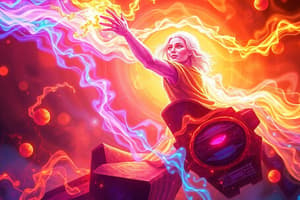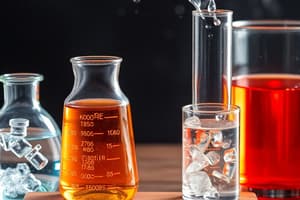Podcast
Questions and Answers
What is an exothermic reaction?
What is an exothermic reaction?
- A reaction that absorbs energy
- A reaction that only occurs in gases
- A reaction that does not involve heat
- A reaction that releases energy (correct)
What is an endothermic reaction?
What is an endothermic reaction?
- A reaction that releases energy
- A reaction that is always exothermic
- A reaction that has no temperature change
- A reaction that absorbs energy (correct)
What’s the main difference between an exothermic and endothermic reaction?
What’s the main difference between an exothermic and endothermic reaction?
An exothermic reaction releases energy and feels warm while an endothermic reaction absorbs energy and feels cool.
Is the reaction when Sara mixed water and calcium chloride exothermic or endothermic?
Is the reaction when Sara mixed water and calcium chloride exothermic or endothermic?
Is the reaction when Samuel mixed baking soda with hydrochloric acid exothermic or endothermic?
Is the reaction when Samuel mixed baking soda with hydrochloric acid exothermic or endothermic?
What kind of reaction occurs when lighting a candle?
What kind of reaction occurs when lighting a candle?
What kind of reaction occurs when melting an ice cube?
What kind of reaction occurs when melting an ice cube?
What kind of reaction occurs when freezing water to make ice?
What kind of reaction occurs when freezing water to make ice?
What kind of reaction occurs when water evaporates?
What kind of reaction occurs when water evaporates?
Are exothermic and endothermic reactions considered physical changes?
Are exothermic and endothermic reactions considered physical changes?
Flashcards are hidden until you start studying
Study Notes
Exothermic and Endothermic Reactions
- Exothermic Reaction: Releases energy, primarily as heat during a chemical reaction.
- Endothermic Reaction: Absorbs energy during a chemical reaction, leading to a temperature drop.
Key Differences
- Exothermic reactions release energy and typically feel warm to the touch.
- Endothermic reactions absorb energy and generally feel cool to the touch.
Reaction Examples
- Calcium Chloride and Water: Mixing causes a temperature increase from 23°C to 52°C, indicating an exothermic reaction.
- Baking Soda and Hydrochloric Acid: Reaction results in bubbling and a temperature drop from 52°C to 22°C, demonstrating an endothermic reaction.
Common Exothermic Reactions
- Candle Lighting: Heat released as the candle burns, exemplifying an exothermic process.
- Freezing Water: Energy is released as water molecules solidify into ice, characterizing an exothermic reaction.
Common Endothermic Reactions
- Melting Ice: Energy is absorbed to melt the ice, illustrating an endothermic process.
- Water Evaporation: Heat absorbed transforms liquid water into vapor, showcasing an endothermic reaction.
Reaction Types
- Both exothermic and endothermic reactions are classified as chemical changes, reflecting the transformation of substances during the process.
Studying That Suits You
Use AI to generate personalized quizzes and flashcards to suit your learning preferences.




